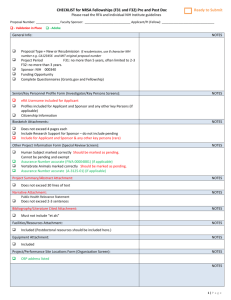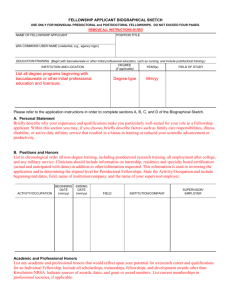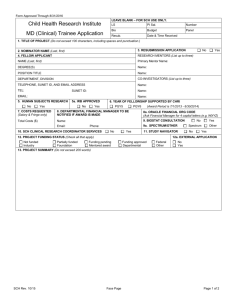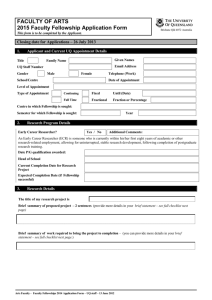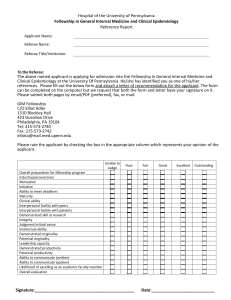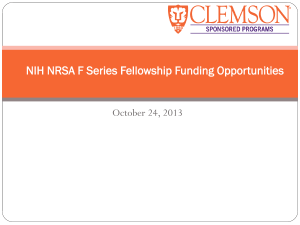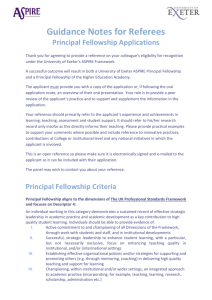Checklists of Required F31 Documents
advertisement
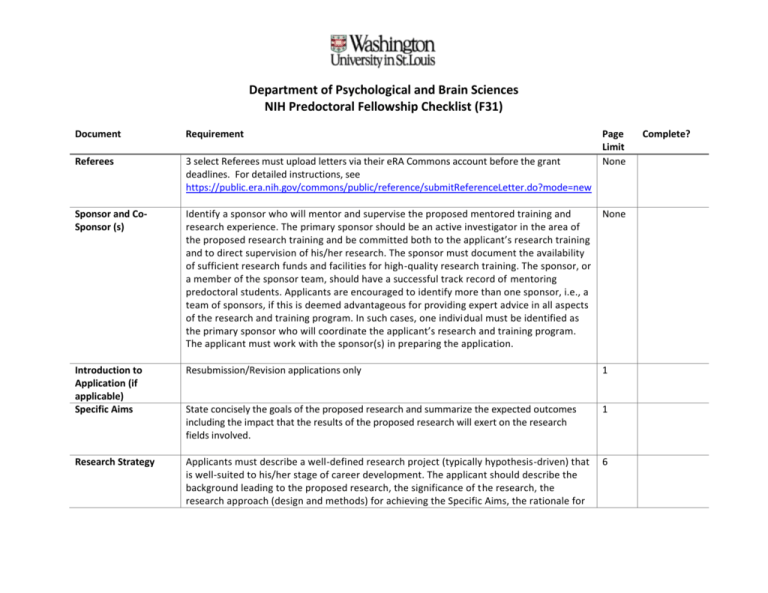
Department of Psychological and Brain Sciences NIH Predoctoral Fellowship Checklist (F31) Document Requirement Page Limit None Referees 3 select Referees must upload letters via their eRA Commons account before the grant deadlines. For detailed instructions, see https://public.era.nih.gov/commons/public/reference/submitReferenceLetter.do?mode=new Sponsor and CoSponsor (s) Identify a sponsor who will mentor and supervise the proposed mentored training and research experience. The primary sponsor should be an active investigator in the area of the proposed research training and be committed both to the applicant’s research training and to direct supervision of his/her research. The sponsor must document the availability of sufficient research funds and facilities for high-quality research training. The sponsor, or a member of the sponsor team, should have a successful track record of mentoring predoctoral students. Applicants are encouraged to identify more than one sponsor, i.e., a team of sponsors, if this is deemed advantageous for providing expert advice in all aspects of the research and training program. In such cases, one individual must be identified as the primary sponsor who will coordinate the applicant’s research and training program. The applicant must work with the sponsor(s) in preparing the application. None Introduction to Application (if applicable) Specific Aims Resubmission/Revision applications only 1 State concisely the goals of the proposed research and summarize the expected outcomes including the impact that the results of the proposed research will exert on the research fields involved. 1 Research Strategy Applicants must describe a well-defined research project (typically hypothesis-driven) that is well-suited to his/her stage of career development. The applicant should describe the background leading to the proposed research, the significance of the research, the research approach (design and methods) for achieving the Specific Aims, the rationale for 6 Complete? Department of Psychological and Brain Sciences NIH Predoctoral Fellowship Checklist (F31) Protection of Human Subjects the proposed approach, potential pitfalls, and expected/alternative outcomes of the proposed studies. It is beneficial to include pertinent preliminary data to demonstrate feasibility. For research that involves human subjects but does not involve one of the six categories of research that are exempt under 45 CFR Part 46, the committee will evaluate the justification for involvement of human subjects and the proposed protections from research risk relating to their participation according to the following five review criteria: 1) risk to subjects, 2) adequacy of protection against risks, 3) potential benefits to the subjects and others, 4) importance of the knowledge to be gained, and 5) data and safety monitoring for clinical trials. No limit For research that involves human subjects and meets the criteria for one or more of the six categories of research that are exempt under 45 CFR Part 46, the committee will evaluate: 1) the justification for the exemption, 2) human subjects involvement and characteristics, and 3) sources of materials. For additional information on review of the Human Subjects section, please refer to the Guidelines for the Review of Human Subjects. Inclusion of Women and Minorities When the proposed project involves human subjects and/or NIH-defined clinical research, the committee will evaluate the proposed plans for the inclusion (or exclusion) of individuals on the basis of sex/gender, race, and ethnicity, as well as the inclusion (or exclusion) of children to determine if it is justified in terms of the scientific goals and research strategy proposed. For additional information on review of the Inclusion section, please refer to the Guidelines for the Review of Inclusion in Clinical Research. No limit Inclusion of Children Provide a description of the plans to include children, including ages to be included or excluded from the proposed research and present an acceptable justification for the exclusion. No limit Vertebrate Animals (if applicable) Describe proposed use of animals in the work outlined in the Research Strategy. Justify use of animals and provide information on the veterinary care of the animals No limit Department of Psychological and Brain Sciences NIH Predoctoral Fellowship Checklist (F31) Project Summary /Abstract No more than 30 lines of text. State the application’s broad, long-term objectives and specific aims making reference to the health relatedness of the project ( i.e., relevance to the mission of the agency) 1 page Project Narrative 3 sentence maximum. Describe relevance of this research to public health. Be succinct and use plain language that can be understood by general, lay audience 1 page Bibliography and References Cited Provide bibliography of any references cited in the Project Narrative. When citing articles that fall under the Public Access Policy, were authored or co-authored by the applicant and arose from NIH support, you must provide the NIH Manuscript Submission reference number or PubMed Central (PMC)/ PMCID number. Citations not covered by the Public Access but are publicly available , provide URL or PubMed number No limit Facilities & Other Resources Identify the facilities (laboratory, animal, computer, office, clinical, and other). If appropriate, indicated their capacities, pertinent capabilities, relative proximity and extend of availability to the project. Describe only those resources directly applicable to the proposed work. No limit Equipment List major items of equipment already available for this project, and if appropriate, identify location and pertinent capabilities No limit Cover Letter Applicants are encouraged to include a cover letter. This letter should include the 1) application title, 2) Funding Opportunity number, 3) Request of assignment to particular awarding component, 4) List of individuals who should NOT review your application and why, 5) Disciplines involved-if multidisciplinary, 6) If late, explain why, 7) If changed/corrected application, explaining why you are submitting the changed/corrected application, 8) Explanation of any subaward budget components that are not active for all periods of the proposed grant, 9) Statement you have attached any required agency approval documentation for the type of application submitted (over $500,000 or agency approval) 1 page Department of Psychological and Brain Sciences NIH Predoctoral Fellowship Checklist (F31) Respective Contributions Describe the collaborative process between you and your sponsor/co-sponsor in the development, review, and editing of this research training plan. Discuss the respective roles in accomplishing the proposed research. 1 page Selection of Sponsor and Institution Describe the rationale/justification for the selection of the sponsor and institution. 1. Explain why the sponsor, co-sponsor (if any), and institution were selected to accomplish the research training goals. If the proposed research training is to take place at a site other than the sponsoring organization, provide an explanation here. 2. Doctorate or Current Institution. (For postdoctoral and senior fellows only) Since training is expected to broaden a fellow's perspective, postdoctoral fellowship applicants requesting training at either their doctorate institution or at the institution where they have been training for more than a year must explain why further training at that institution would be valuable. Individuals applying for Senior Fellowships who are requesting training at the institution at which they are employed should provide a similar explanation. 3. Foreign Institution. If you are proposing a research training experience at a foreign institution, show that the foreign institution and sponsor offer special opportunities for training that are not currently available in the United States. Key factors in the selection of a foreign institution should be described. If applicable, the need for and level of proficiency in reading, speaking, and comprehending the foreign language should be addressed. Save this information in a single file in a location you remember. 1 page Responsible for Conduct of Research All applications must include a plan to fulfill NIH requirements for instruction in the Responsible Conduct of Research (RCR). The plan must address the five, required instructional components outlined in the NIH policy: 1) Format - the required format of instruction, i.e., face-to-face lectures, coursework, and/or real-time discussion groups (a plan with only on-line instruction is not acceptable); 2) Subject Matter - the breadth of subject matter, e.g., conflict of interest, authorship, data management, human subjects and animal use, laboratory safety, research misconduct, research ethics; 3) Faculty Participation - the role of the mentor(s) and other faculty involvement in the instruction; 4) Duration of Instruction - the total number of contact hours of instruction; and 5) 1 page Department of Psychological and Brain Sciences NIH Predoctoral Fellowship Checklist (F31) Frequency of Instruction – instruction must occur during each career stage and at least once every four years. Document any prior instruction during the applicant’s current career stage, including the inclusive dates instruction was last completed. See also NOTOD-10-019. Applications lacking a Plan for Instruction in the Responsible Conduct of Research will not be reviewed. Goals for Fellowship and Career Discuss how the proposed research project and activities enhance the applicant’s development and relate to the applicant’s career goals as a productive, independent research scientist. Discuss how the proposed research training plan will enhance his/her knowledge and technical and professional skills, and facilitate his/her transition to the next career stage. 1 page Activities Planned under this Award The applicant’s research training plan, i.e. the activities planned under this award, should be individually tailored and well integrated with his/her research project. Describe the skills and techniques that the applicant intends to learn as well as any planned, nonresearch activities (e.g. those relating to professional development) during the award period. The applicant should provide a timeline for the proposed research training and related activities 1 page Doctoral Dissertation and Research Experience Summarize your research experience in chronological order. Advanced graduate students, who have (or will have) completed their comprehensive examinations by the time of award must also include a narrative of their doctoral dissertation (may be preliminary). If you have no research experience, list other scientific experience. Do not list academic courses. In summarizing their research experience, Postdoctoral and Senior Fellowship applicants should include the areas studied and conclusions drawn. Postdoctoral fellowship applicants should also specify which areas of research were part of their thesis or dissertation and which, if any, were part of a previous postdoctoral project. 2 pages Sponsor and CoSponsor Information The sponsor(s) should describe their current research support and how this support relates to the applicant’s proposed research project. A contingency plan should be 6 pages Department of Psychological and Brain Sciences NIH Predoctoral Fellowship Checklist (F31) provided that describes how the applicant’s research training will be supported should there be a gap in the sponsor’s funding during the proposed award period. The role of the sponsor in the integrated research and training plan should be described. If a team of sponsors is proposed, this plan should describe the role of each sponsor and how they will communicate and coordinate their efforts to mentor the applicant effectively. Sponsor Biosketch The training plan should be individualized for the applicant, keeping in mind the applicant’s strengths and any gaps in needed skills, and should be designed to enhance research training. The training plan should be coordinated with the applicant’s Research Strategy. The training plan should outline and justify new training opportunities, any relevant coursework, and professional development activities. Training in professional development skills, e.g. grant-writing and presentation skills, is strongly encouraged. The training plan should have the potential to facilitate the applicant’s transition to the next stage of his/her career Use new format. See https://grants.nih.gov/grants/guide/notice-files/NOT-OD-15-024.html Co-Sponsor(s) Biosketch Fellow Biosketch Use new format. See https://grants.nih.gov/grants/guide/notice-files/NOT-OD-15-024.html Additional Educational Information Describe the graduate program in which the applicant is enrolled, e.g. the structure of the program, required milestones and their usual timing (number of courses, any teaching commitments, qualifying exams, etc.), and the average time to degree over the past 10 years. Describe the progress/status of the F31 applicant in relation to the program's time line. Describe the frequency and method by which the program formally monitors and evaluates a student's progress. This information is typically provided by the director of the graduate program or the department chair. Include the name of the individual providing this information at the end of the description. Use custom biosketch. See sample below 5 pages 5 pages 5 pages 5 Department of Psychological and Brain Sciences NIH Predoctoral Fellowship Checklist (F31) applicant's courses and grades must be included in the Fellowship Applicant Biographical Sketch, and NOT in this attachment. Additional Educational Information” Planned Enrollment Report When conducting clinical research, this table should be completed and accompany the application 1 page Cumulative Inclusion Enrollment Report When conducting clinical research, this table should be completed and accompany the application 1 page Separate attachment (see sample) Separate attachment (see sample) Department of Psychological and Brain Sciences NIH Predoctoral Fellowship Checklist (F31) OMB No. 0925-0001 (Rev. 08/12 Approved Through 8/31/2015) APPLICANT BIOGRAPHICAL SKETCH—Instructions (see below for Actual Predoctoral Sample) Use only for individual predoctoral and postdoctoral fellowships, dissertation research grants (R36),and Research Supplements to Promote Diversity in Health-Related Research (Admin Suppl). DO NOT EXCEED FIVE PAGES. NAME OF APPLICANT: eRA COMMONS USER NAME (credential, e.g., agency login): POSITION TITLE: EDUCATION/TRAINING (Most applicants will begin with baccalaureate or other initial professional education, such as nursing. Include postdoctoral training and residency training if applicable. High school students should list their current institution and associated information. Add/delete rows as necessary.) INSTITUTION AND LOCATION DEGREE (if applicable) START DATE MM/YYYY END DATE (or expected end date) MM/YYYY FIELD OF STUDY NOTE: The Biographical Sketch may not exceed five pages. Follow the formats and instructions below. Department of Psychological and Brain Sciences NIH Predoctoral Fellowship Checklist (F31) A. Personal Statement Briefly describe why you are well-suited to receive the award for which you are applying. The relevant factors may include aspects of your training; your previous experimental work on this specific topic or related topics; your technical expertise; your collaborators or scientific environment; and your past performance in this or related fields (you may mention specific contributions to science that are not included in Section C). Also, you may identify up to four peer-reviewed publications that specifically highlight your experience and qualifications for this project. If you wish to explain impediments to your past productivity, you may include a description of factors such as family care responsibilities, illness, disability, and active duty military service. B. R36 Applicants (PD/PI) Only: In addition to the information outlined above, include a description of your career goals and intended career trajectory, as well as your interest in the specific areas of research designated in the FOA. Diversity Supplement Candidates Only: In addition to the information outlined above, include a description of your general scientific achievements and/or interests, as well as your specific research objectives and career goals. Indicate any source(s) of current funding. Positions and Honors List in chronological order all non-degree training, including postdoctoral research training, all employment after college, and any military service. High school students and undergraduates may include any previous positions. Clinicians should include information on internship, residency and specialty board certification (actual and anticipated with dates) in addition to other information requested. This information is used in the reviewing the application and in determining the stipend level for Postdoctoral Fellowships. State the Activity/Occupation and include start/end dates, field, name of institution/company, and the name of your supervisor/employer. If you are not currently located at the applicant organization, include your projected position at the applicant organization as well. Department of Psychological and Brain Sciences NIH Predoctoral Fellowship Checklist (F31) ACTIVITY/ OCCUPATION START ENDING DATE DATE (mm/yy) (mm/yy) FIELD INSTITUTION/ COMPANY SUPERVISOR/ EMPLOYER Academic and Professional Honors List any academic and professional honors that would reflect upon your potential for a research career and qualifications. Include all scholarships, traineeships, fellowships, and development awards. Indicate sources of awards, dates, and grant or award numbers. List current memberships in professional societies, if applicable. C. Contributions to Science (for predoctoral students and more advanced candidates only; high school students, undergraduates, and postbaccalaureates should skip this section) Considering your level of experience, briefly describe your most significant contributions to science. While all applicants may describe up to five contributions, graduate students and postdoctorates are encouraged to consider highlighting two or three they consider most significant. These may include research papers, abstracts, book chapters, reviews, as well as non-publication research products, such as materials, methods, models, or protocols. For each contribution, indicate the historical background that frames the scientific problem; the central finding(s); the relevance of the finding(s) to science, technology, or public health; and your specific role in the described work. For each contribution, you may reference up to four peer-reviewed publications or other non-publication research products (can list audio or video products; patents; data and research materials; databases; educational aids or curricula; instruments or equipment; models; protocols; and software or netware) that are relevant to the described contribution. The description of each contribution should be no longer than one half page including figures and citations. Please also provide a URL to a full list of your published work as found in a publicly available digital database such as SciENcv or My Bibliography, which are maintained by the US National Library of Medicine. Manuscripts listed as “pending publication” or “in preparation” should be included and identified. Indicate if you previously used another name that is reflected in any of the citations. Department of Psychological and Brain Sciences NIH Predoctoral Fellowship Checklist (F31) D. Scholastic Performance Predoctoral applicants: Using the chart provided, list by institution and year all undergraduate and graduate courses with grades. In addition, in the space following the chart, explain any marking system if other than 1-100, A, B, C, D, F, or 0-4.0 if applicable. Show levels required for a passing grade. Postdoctoral applicants: Using the chart provided, list by institution and year all undergraduate courses and graduate scientific and/or professional courses germane to the training sought under this award with grades. In the space following the chart, explain any marking system if other than 1-100, A, B, C, D, F, or 0-4.0 if applicable. Show levels required for a passing grade. YEAR SCIENCE COURSE TITLE GRADE YEAR OTHER COURSE TITLE GRADE OMB No. 0925-0001 (Rev. 08/12 Approved Through 8/31/2015) APPLICANT BIOGRAPHICAL SKETCH SAMPLE—PREDOCTORAL FELLOWS (Note this Sample is for a Predoctoral Fellowship Applicant only and does not include information specific to R36 or Diversity Supplements. For a Postdoctoral Fellowship Sample, see: http://grants.nih.gov/grants/funding/424/postdocfellowshipbiosample.docx) Use only for individual predoctoral and postdoctoral fellowships, dissertation research grants (R36), and Research Supplements to Promote Diversity in Health-Related Research (Admin Suppl). DO NOT EXCEED FIVE PAGES. Department of Psychological and Brain Sciences NIH Predoctoral Fellowship Checklist (F31) NAME OF APPLICANT: Leilani Robertson-Chang eRA COMMONS USER NAME (credential, e.g., agency login): RobertsonL POSITION TITLE: Graduate Student Research Assistant EDUCATION/TRAINING (Most applicants will begin with baccalaureate or other initial professional education, such as nursing. Include postdoctoral training and residency training if applicable. High school students should list their current institution and associated information. Add/delete rows as necessary.) INSTITUTION AND LOCATION Swarthmore College UC San Diego A. DEGREE (if applicable) START DATE MM/YYYY B.A. 08/2008 END DATE (or expected end date) MM/YYYY 05/2012 Ph.D. 08/2012 05/2018 FIELD OF STUDY Biology Molecular Biology Personal Statement My long term research interests involve the development of a comprehensive understanding of key developmental pathways and how alterations in gene expression contribute to human disease. My academic training and research experience to date have provided me with an excellent background in molecular biology and microbiology. While in high school I was awarded an NIH Diversity Supplement award to work as a research technician for two summers in Dr. Indira Creative’s lab at the University of Hawaii. As an undergraduate at Swarthmore College, I conducted research with Dr. Xavier Factor on the mechanisms of action of a new class of antibiotics. This resulted in a co-authorship publication, as well as an invitation to present a poster at the annual Antibiotica meeting in Denver, Colorado. For my graduate training at UC San Diego, I have moved into the fields of genetics and biochemistry by studying the regulation of transcription in yeast, under Dr. Tanti Auguri. Dr. Auguri is an internationally recognized leader in the field of yeast genetics and has an extensive record for training predoctoral and postdoctoral fellows. Along with giving me new conceptual and technical training, the proposed training plan outlines a set of career development activities and workshops – e.g. Department of Psychological and Brain Sciences NIH Predoctoral Fellowship Checklist (F31) public speaking, literature analysis, biomedical ethics, and career options. For my initial project I am currently developing a novel protocol for the purification for components of large transcription complexes which I hope to submit as a first author publication in the next few months. As a native Hawaiian, I am the first in my family to graduate from college so I am excited to keep pushing forward with my education. Overall, I feel that my choice of sponsor, research project, and the training I will get from this fellowship will give me a solid foundation for my long-term goal to become an academic researcher. B. Positions and Honors ACTIVITY/ OCCUPATION START END DATE DATE (mm/yy) (mm/yy) Lab Technician (Summers) 06/07 Predoc 08/12 08/08 FIELD Biology Present Molecular biology INSTITUTION/ COMPANY SUPERVISOR/ EMPLOYER University of Hawaii I.M Creative UC San Diego Xavier Factor Academic and Professional Honors Daughters of Hawaii Scholarship, 2008 National Merit Scholarship, 2008-2012 Paula F. Laufenberg award for best senior project in the Biology Department, Swarthmore College, 2012 B.S. awarded with high honors, Swarthmore College, 2012 NIH Diversity Supplement 2007-2008 (Summers) Memberships in Professional Societies Sigma Xi Association for Women in Science Department of Psychological and Brain Sciences NIH Predoctoral Fellowship Checklist (F31) C. Contributions to Science My contributions to science are organized to reflect the different research projects I have worked on to date, in high school, college, and now in graduate school. I. High School Research: I spent two summers doing research in the laboratory of Dr. Indira M. Creative at University of Hawaii, funded by a NIH Diversity Supplement award. Dr. Creative has developed several new anti-fungal drugs that might protect against skin infections. Over the course of two summers I set up in vitro cultures of skin cell lines and conducted a wide range of toxicity assays. We were excited to find that one of the new agents showed almost no toxicity, even at fairly high doses. Dr. Creative is now testing the drug in animals exposed to different types of fungal infections, including Candida albicans. Abstracts Footman, B., Eisser, J.K., Robertson-Chang, L. and Creative, I.M. 1998. Testing XXH for toxicity in vitro. Abstract for poster presentation, University of Hawaii Research Symposium, Manoa, HI. II. Undergraduate Research: I was part of a project in the laboratory of Dr. Xavier Factor at Swarthmore College. Dr. Factor’s laboratory studies the mechanisms of action of antibiotics. During my time in his lab I was looking at how a new antibiotic, Gen Y, is able to unravel bacterial DNA. The work was particularly exciting because it looks like the mechanism used by Factor Y might be completely novel, making it a potential candidate for treating patients infected with antibiotic resistant organisms. Dr. Factor was recently awarded a patent for this new drug. Research papers Nieman, P.Y., Robertson-Chang, L., Pearson, K. and Factor, X. 2003. Gen Y: a novel antibiotic with DNA unwinding abilities. Cell. Mol. Biol. 30: 25-30. Abstracts Robertson-Chang, L. and Factor, X. Testing the ability of antibiotic Gen Y to kill Gram-negative bacteria. Abstract for poster presentation. 2002. Antibiotica annual meeting, Denver, Colorado, September 2002. III. Graduate Research: My ongoing predoc research is focused on transcriptional gene regulation in Saccharomyces cerevisiae. I believe the results from my research will likely be highly relevant to human health as they will provide new details into the workings of complex biological systems, which will allow for further extrapolations into the development of certain diseases and their progression. Department of Psychological and Brain Sciences NIH Predoctoral Fellowship Checklist (F31) I am currently developing a novel protocol for the purification for components of large transcription complexes which I hope to submit as a first author publication in the next few months. Research papers Robertson-Chang L and Auguri, T. 2005. A tandem affinity purification tag approach allows for isolation of interacting proteins in Saccharomyces cerevisiae. In preparation. Abstracts Robertson-Chang L and Auguri, T. A tandem affinity purification tag approach allows for isolation of interacting proteins in Saccharomyces cerevisiae. Abstract for poster presentation, 2004 Yeast Genetics and Molecular Biology Meeting, Seattle, Washington, September 2004. D. Scholastic Performance YEAR SCIENCE COURSE TITLE GRADE YEAR SWARTHMORE COLLEGE OTHER COURSE TITLE GRADE SWARTHMORE COLLEGE 2008 Cellular and Molecular Biology A 2008 2008 Foundations of Chemical Principles A 2009 2009 Organismal and Population Biology B 2009 2009 Omics B 2010 2009 General Physics I B 2011 2009 Introductory Chemistry A 2011 2009 Organic Chemistry I B First Year Seminar: Nation and Migration Statistics, Probability, and Reliability Calculus I American Literature Anthropology of Childhood and the Family Disease, Culture and Society in the Modern World A A B B A A Department of Psychological and Brain Sciences NIH Predoctoral Fellowship Checklist (F31) YEAR SCIENCE COURSE TITLE GRADE YEAR 2010 General Physics II B 2010 B 2010 Organic Chemistry II Microbial Pathogenesis and the Immune Response Introduction to Cognitive Science 2010 Biological Chemistry B 2011 Human Genetics A 2011 Senior Project A 2011 Bioinformatics B 2012 Cell Biology A 2012 Physics in Modern Medicine A 2012 Genomics and Systems Biology A 2012 Senior Project A 2010 A A UC SAN DIEGO 2012 Seminar in Genetics P 2013 Statistics for the Life Sciences P 2013 Ethics in Biological Research CRE 2014 Seminar in Physiology & Behavior P OTHER COURSE TITLE GRADE Department of Psychological and Brain Sciences NIH Predoctoral Fellowship Checklist (F31) Except for the scientific ethics course, UC San Diego graduate courses are graded P (pass) or F (fail). Passing is C plus or better. The scientific ethics course is graded CRE (credit) or NC (no credit). Students must attend at least seven of the eight presentation/discussion sessions for credit.
